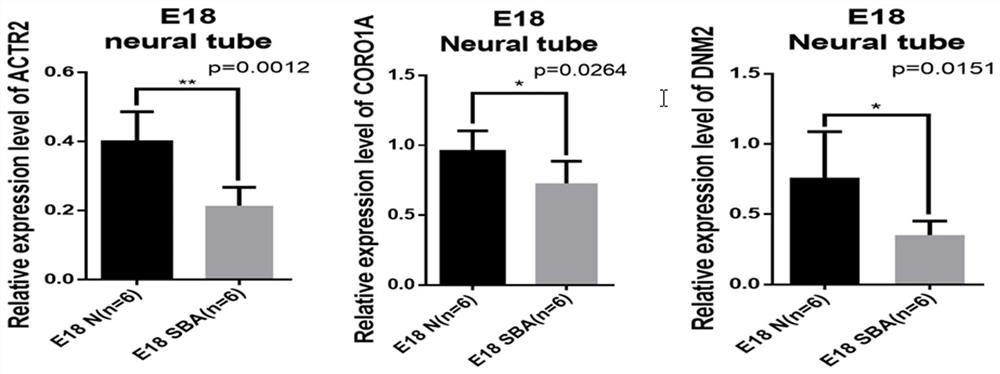Molecular marker for antenatal noninvasive diagnosis of fetus with neural tube malformation, congenital heart disease or cleft lip and palate and application of molecular marker
A technology for congenital heart disease and neural tube defects, applied in the field of medicine and biology, can solve problems such as the lack of clinical application of diagnostic molecular markers
- Summary
- Abstract
- Description
- Claims
- Application Information
AI Technical Summary
Problems solved by technology
Method used
Image
Examples
Embodiment 1
[0043] Example 1 Screening of differentially expressed proteins in the peripheral blood of pregnant mice with neural tube defects using proteomics technology and bioinformatics analysis.
[0044] Ultrahigh-speed centrifugation was used to separate plasma exosomes from pregnant mice with neural tube defects, and the identification of exosomes was completed. Use label-free quantitative technology (label-free) for proteomics screening, combined with bioinformatics analysis, to initially screen possible protein markers, such as Figure 1-3 shown.
[0045] 1. Separation of plasma.
[0046] Collect the whole blood sample, put it in an EDTA anticoagulant tube, mix it upside down gently, use a 4°C low-temperature centrifuge, centrifuge at 1600×g for 10 minutes, collect the supernatant (plasma) into a new EP tube, and centrifuge at 16000×g After 10 minutes to remove cell debris, the plasma was divided into several centrifuge tubes.
[0047] 2. Isolation and identification of exosome...
Embodiment 2
[0054] Example 2 Verify the expression of ACTR2, CORO1A and DNM2 in serum exosomes of neural tube defects.
[0055] 1. The expression of ACTR2, CORO1A and DNM2 was verified in the serum exosomes of embryonic day E18.
[0056] 19 pairs of embryonic E18 days samples other than omics detection were selected for Western-blot expansion sample size verification. The validation used Alix as an internal control to detect ACTR2 at 45 kDa, CORO1A at 57 kDa and DNM2 at 98 kDa. A total of 19 pairs of samples (19 normal and 19 neural tube defects) derived from serum exosomes of pregnant mice were tested, and they were found to be consistent with the trend of omics results, all of which were low-expressed in the abnormal group. The statistical results also showed that there were statistical differences in the low expression of ACTR2, CORO1A and DNM2 in the neural tube defect group. The detection of CORO1A by ELISA also confirmed the consistency of Western-blot results.
[0057] 2. The ex...
Embodiment 3
[0060] Example 3 Expression of ACTR2, CORO1A and DNM2 in spinal cord tissue and embryonic neurogenic exosomes.
[0061] 1. The expression of ACTR2, CORO1A and DNM2 in spinal cord tissue.
[0062] In order to explore the relationship between ACTR2, CORO1A and DNM2 and the occurrence of neural tube defects, and to clarify their expression in the spinal cord tissue, Western-blot was used to detect the expression in the spinal cord tissue of embryonic E18 and E12 days, and β-actin was used as the tissue Internal reference for detection. The results showed that consistent with the trend of serum exosomes, ACTR2, CORO1A, and DNM2 all showed a statistically significant down-regulation trend in spinal cord tissues with neural tube defects. Immunohistochemical staining showed the expression of ACTR2, CORO1A and DNM2 in the spinal cord tissues of neural tube defects on day E18, to clarify whether these proteins were specifically expressed in neural tube tissues. ACTR2 is expressed in ...
PUM
 Login to View More
Login to View More Abstract
Description
Claims
Application Information
 Login to View More
Login to View More - R&D
- Intellectual Property
- Life Sciences
- Materials
- Tech Scout
- Unparalleled Data Quality
- Higher Quality Content
- 60% Fewer Hallucinations
Browse by: Latest US Patents, China's latest patents, Technical Efficacy Thesaurus, Application Domain, Technology Topic, Popular Technical Reports.
© 2025 PatSnap. All rights reserved.Legal|Privacy policy|Modern Slavery Act Transparency Statement|Sitemap|About US| Contact US: help@patsnap.com



